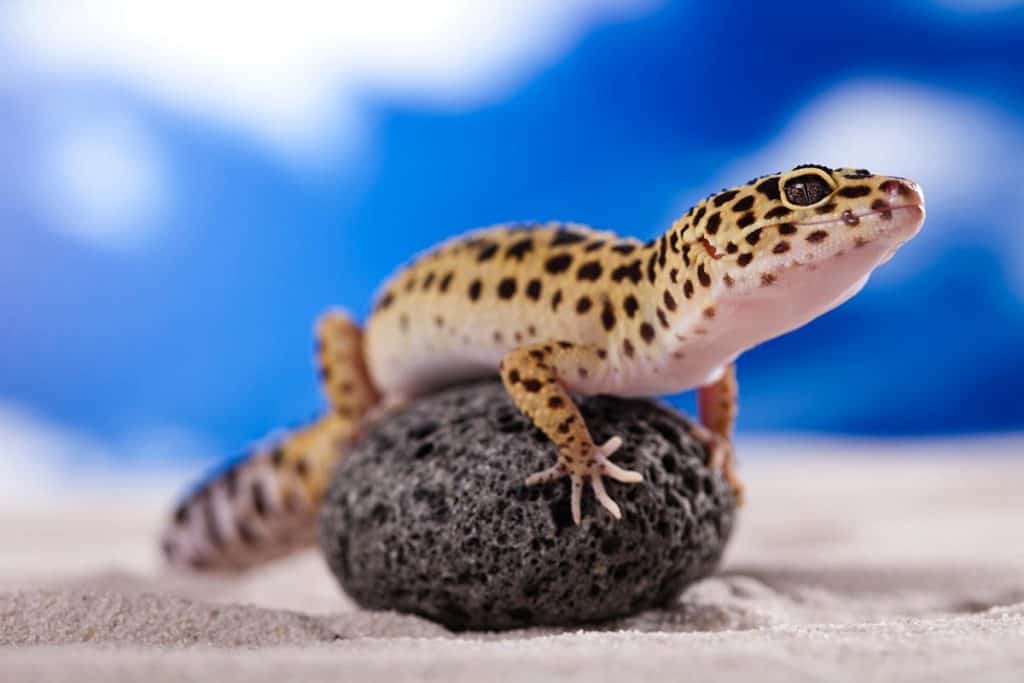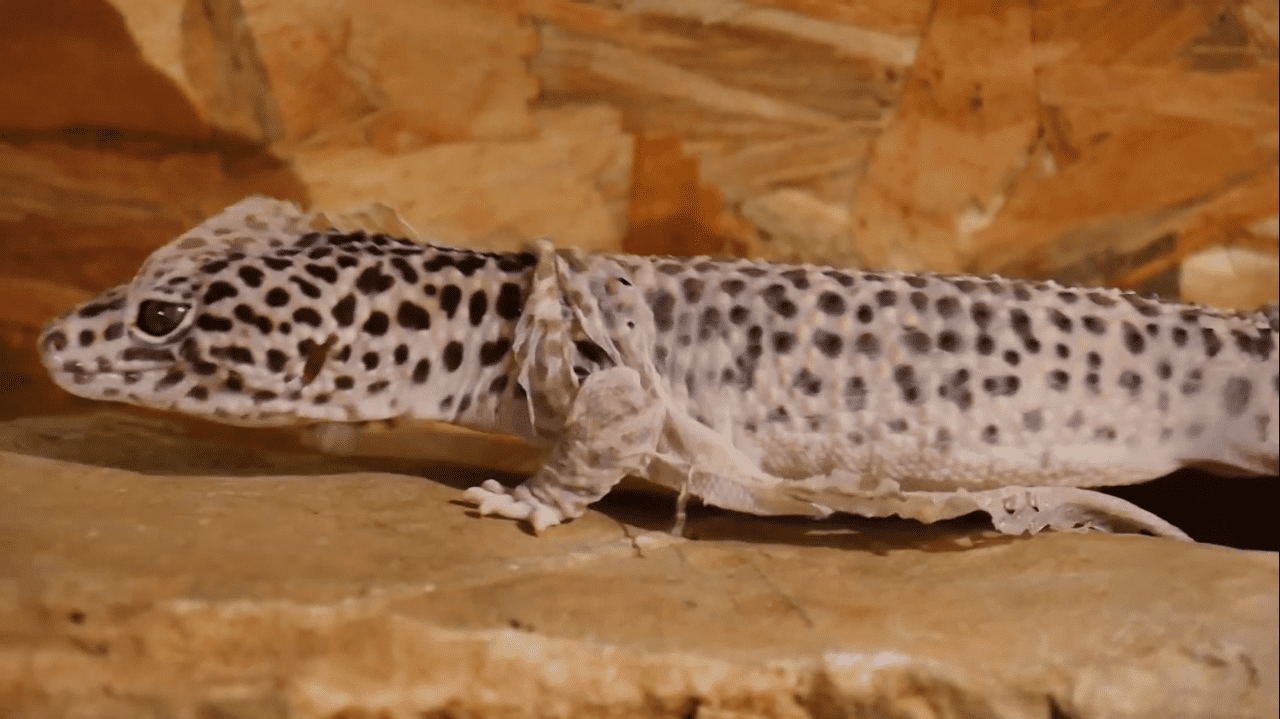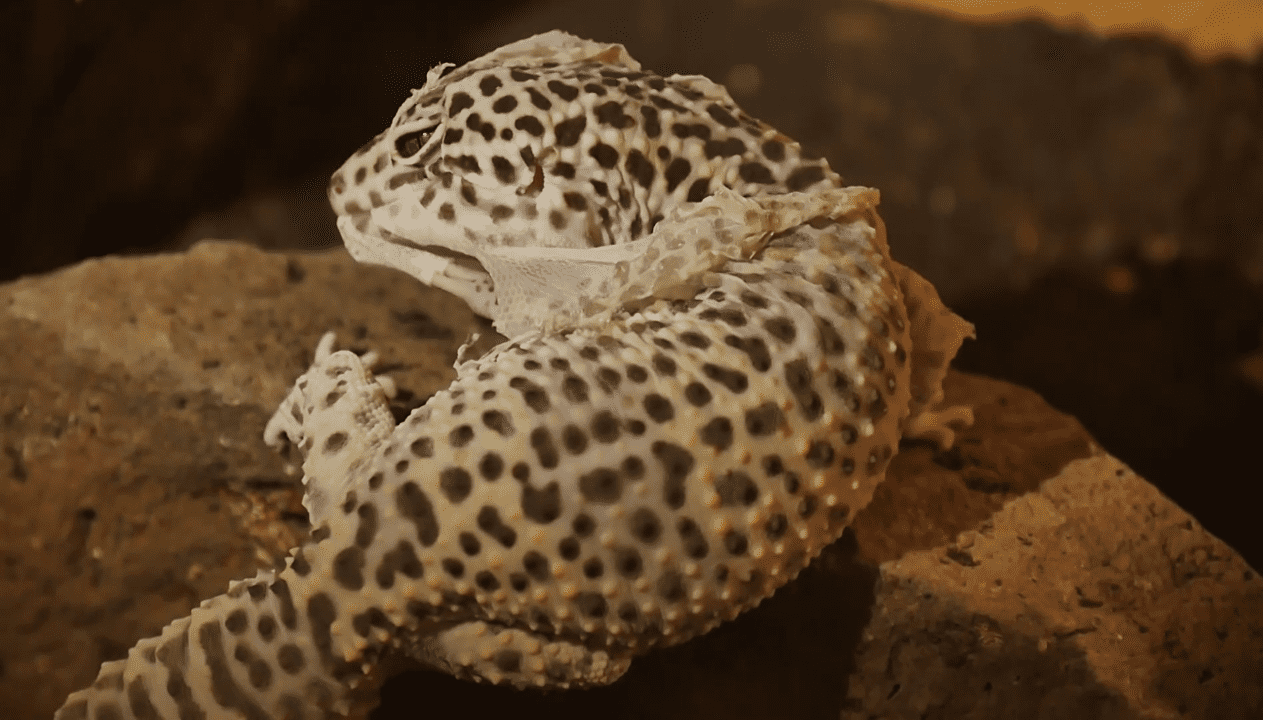Leopard geckos, like all other reptiles, shed their skin periodically throughout their lifetimes. Shedding is a natural process for leopard geckos, but it can be especially worrisome for newbie keepers. If you’ve never seen a reptile shedding before, you’re probably wondering how often leopard geckos shed. You might also want to know what you can do to help your pet shed.
Unlike most other lizards whose skin sheds in flakes and falls off in pieces over several days, leopard geckos shed their entire skin all at once. Leopard gecko shedding is generally a no-fuss, no-muss process and is an ordinary event for experienced gecko keepers.
However, certain problems can happen along the way and disrupt your gecko’s shedding process. A stuck shed is a common and very uncomfortable condition that can cause your gecko to lose a toe, their tail, or even get a severe skin infection!
Even a normal shedding process can be extremely stressful for first-time keepers, so it’s best to know what to expect when the time comes! Continue reading to learn the ins and outs of gecko shedding!
Why Do Leopard Geckos Shed?
Skin shedding is a common occurrence in the animal world and happens for many different reasons. This process isn’t only characteristic for reptiles, as people too are constantly shedding their skin. In fact, both you and I are shedding at this very moment, and we do so on a rather consistent basis.
The only real difference between us and leopard geckos is that they shed all of their outer skin cells at once, while our skin sheds in tiny flakes that are usually too small to see.
The most important reason why the pet geckos shed is to make room for their growing bodies. Since reptile skin isn’t very elastic, leopard geckos and other lizards have to shed periodically to extend their skin to fit snugly over their bodies.
Besides replacing old skin cells with new ones, shedding also helps leopard geckos to develop their adult coloration, remove external parasites, and heal skin injuries or any damage to their skin.
Wild geckos use shedding to remove parasites like mites and ticks, which carry many diseases. Also, shedding a few months in a row can help a gecko to heal and recover from bites, scratches, or other skin injuries.
Leopard gecko shedding is a completely normal phenomenon that will happen many times throughout your pet’s lifespan.
How Often Do Leopard Geckos Shed?
Leopard gecko shedding occurs at different times and rates for individual lizards since many different factors influence the frequency of shedding. Growth rate, injury, reproductive status, and health can all affect how often baby leopard geckos shed and the time between their shedding cycles.
Having said that, you can expect baby and young geckos to shed weekly or bi-weekly. Baby leopard geckos grow fast and shed much more often than older geckos.
Their constantly growing bodies need more room to continue to develop and grow, so young geckos have to upsize their skins regularly. Bear in mind that the more your baby leopard gecko is eating, the more often they’ll need to shed to accommodate for the faster growth rate.
Between the ages of six months and one and a half years, most geckos shed only once a month. Adult leos, on the other hand, shed once every four to eight weeks.
So long as your leopard gecko looks and acts normal and is healthy, you don’t have to worry too much about the frequency of your pet’s shedding. As mentioned above, there are a lot of things that influence when leopard geckos shed, so it’s hard to predict a fault-proof shedding schedule.
How Long Does It Take for a Leopard Gecko to Shed?
Skin shedding is a natural process that will happen over and over again during your pet leopard gecko’s lifespan. While skin shedding can seem scary and difficult to a novice keeper, it’s not a strenuous or long process for a healthy gecko.
You’ll know your pet gecko is starting to shed if their skin is becoming more gray and dull than usual. Once you notice this change in the skin color, it usually takes one to three days before the shed is complete.
Once the actual skin shedding process takes off, the whole thing can be over in as little as 10 minutes. However, this isn’t always the case, and some leopard geckos can take up to a full day to shed completely.
Shedding and growing new skin requires a lot of energy, so it’s normal for leopard geckos to appear sluggish and lethargic for a few days leading up to a shed. This is nothing to worry about as long as your pet starts behaving as they normally would after the shed is completed.
If your leopard gecko doesn’t return to its usual energy levels and remains lethargic three days after the shed, they may have an underlying health problem. In this case, take your gecko to an exotic veterinarian for a full checkup.
What Are the Signs of Gecko Shedding?
A clear sign that your leopard gecko will start to shed soon is the change of their skin color. Around one week before the actual shed, the gecko’s body will start to produce a layer of liquid between the old skin layer and the new skin. This liquid serves as a lubricant and should help the old skin simply slide off a gecko’s body.
When this is done, the old skin will loosen a bit, which causes leopard geckos to look faded and appear grayish-white.
You may notice that your gecko’s colors aren’t as vibrant as before and that their pattern isn’t as easily seen as before. While this change can be hard to spot in pale or albino gecko species, it’s visible in wild-type and melanistic leopard geckos, who will change from dark brown to grayish-white.
Besides the change in appearance, your leopard gecko may also start behaving differently in preparation for the shed.
Since leopard geckos need moisture and humidity to complete the shed painlessly, your pet gecko may spend more time in its moist hide, or just hide more than usual. When close to shedding, most geckos will also lose interest in food or have a significantly decreased appetite a week or so before shedding.
As the time for shedding comes, you may notice that your pet is rubbing their body against rocks, branches, or other tank decorations. Some leopard geckos will start to move strangely and may even bite their skin at this time. If this happens, don’t worry! This is your pet’s way of trying to remove the old skin faster.
Sometimes, the old skin will come off in a single piece, similar to the way snakes shed. However, the shedding skin may also break into several larger pieces that will simply fall off your pet leopard gecko’s body.
Most Common Leopard Gecko Shedding Problems
The stuck shed is the most common and virtually the only problem leopard geckos can experience while shedding. This refers to a piece of old skin that is stuck and won’t come off on its own. The most likely causes for stuck shed are:
- Health problems or stress
- Vitamin deficiency
- Low humidity and lack of moisture hide in the tank
- Poor living conditions
Having said that, not all cases of stuck shed are the result of these issues. Some leopard geckos are naturally poor shedders and may experience shedding difficulties for no apparent reason.
As time goes by, the stuck skin will become dry and hard, causing a variety of different problems depending on its position on the gecko’s body.
For leopard geckos, the toes are the most common places where the stuck shed occurs. The hardening of the stuck shed on toes is especially problematic, as it can cut off the blood supply from the toe, damaging the surrounding tissues and nerves. If the situation doesn’t get better, your leopard gecko could lose a toe or get a severe infection.
How to Help if Your Leopard Gecko Has Stuck Shed
Health problems, lack of humidity, poor diet, and unsuitable living conditions are the most likely causes of a stuck shed in leopard geckos. Additionally, vitamin A deficiency, external parasites, or a severe injury can also cause a stuck shed.
If you notice your leopard gecko hasn’t completed the shedding process after 24 hours, don’t panic! Instead, try the following tips to loosen your pet’s stuck skin.
1. Bathing
Find a plastic container and fill it with lukewarm water, making sure that it’s not over your leopard gecko’s chin level. Place your reptile inside and let it soak for 5 to 10 minutes or until the water starts to cool. Bathing your leopard gecko will hydrate their skin and can help loosen the stuck shed and make it easier to remove.
2. Misting
Using a spray bottle to mist your leopard gecko directly can also help soften the stuck shed. If you decide to use this method, don’t spray your pet on its head and face, as this is uncomfortable and can make them afraid of you.
Again, it’s best to use lukewarm water and spray your pet with a very fine mist. After 20 to 30 minutes, use a small towel to pat your leopard gecko dry. Their stuck shed should now be easier to remove.
3. Shedding Aid
If bathing and misting don’t work, you can try spraying your pet with a shedding aid. These products usually contain water combined with vitamin E, jojoba oil, and aloe that hydrate the skin and help with a stuck shed. Spray the shedding aid directly on your pet gecko’s skin and carefully rub it using a cotton swab.
4. Moist Hide
Having a moist hide can help with the shedding process immensely if the leopard gecko can climb inside it as soon as it starts shedding. Use a damp paper towel, moss, or coconut fiber to fill the inside of the hide.
Ideally, the hide should be large enough for your leopard gecko to fit in comfortably but should have a small opening that will prevent humidity from evaporating into thin air.
If your leopard gecko gets a chance to use the moist hide as soon as its shedding begins, it’s highly unlikely that you’ll have to bathe or mist them after.
5. Tank Decorations
A lack of rough surfaces inside your leopard gecko’s tank setup is one of the main causes of a stuck shed. Without coarse surfaces to rub onto, your leopard gecko will have to use its teeth to pull the shedding skin off their bodies. While there isn’t anything wrong with pulling skin like that, your gecko won’t be able to reach all the spots with its mouth.
Having appropriate tank decorations like stones and branches can help your pet to rub off the shedding skin from their face, nose, tail, and back.
FAQs Leopard Geckos Shedding
Do leopard geckos eat when shedding?
It’s completely normal for leopard geckos to stop eating or to eat less than usual when they start shedding. However, some will continue to eat normally both before and after the shedding process. As soon as a leopard gecko finishes shedding, they should start eating regularly again.
What does it mean when a leopard gecko sheds a lot?
It’s normal for young leopard geckos to shed once a week or bi-weekly, while adults usually shed every four to eight weeks. If your leopard gecko is shedding more than this, they could be sick, stressed, dehydrated, or malnourished. Other likely causes for excessive shedding are parasites, mites, lack of a hiding area, and thermal burns.
Shedding Your Fears
Although it seems scary, shedding is a natural process all leopard geckos go through. Knowing how often leopard geckos shed can help you get prepared for the moment your pet reptile starts peeling off its skin. Leopard gecko shedding depends on many factors, mainly their age, size, and health.
Since they are growing rapidly, baby leopard geckos tend to shed the most and will replace their entire skin once or bi-weekly. Adult leos, on the other hand, shed every four to eight weeks or less often depending on their diet, environment, and overall health.
Do you have a leopard gecko? Has your pet reptile gone through its first shed? Share your tips for a successful gecko shedding with us and our readers in the comment section below!




